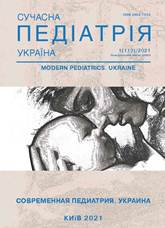Systemic therapy of allergic dermatosis in children (literature review)
DOI:
https://doi.org/10.15574/SP.2021.113.62Keywords:
children, allergy, allergic dermatoses, systemic therapy, internal therapyAbstract
Allergic pathology of skin is one of the most pressing problems of modern pediatry. The most common allergic dermatoses: simple and allergic contact dermatitis, atopic dermatitis, various forms of eczema, acute and chronic allergic urticaria, Quincke's edema, toxicodermias, multiforme exudative erythema (Stevens-Johnson syndrome), acute epidermal necrolysis (Lyell's syndrome). Many aspects of systemic treatment of allergic dermatoses in children are complex and controversial. The modern strategy of treatment of allergic dermatoses in children is based on the principles of evidence-based medicine. According to the international program documents EAACI (European Academy of Allergy and Clinical Immunology), AAAAI (American Academy of Allergy, Asthma & Immunology), PRACТALL (Practical Allergology Consensus Report) treatment of allergic dermatoses consists of: environmental control to eliminate allergenic and non-allergenic factors, skin care, systemic and local pharmacotherapy. Systemic pharmacotherapy includes using drugs of the following groups: antihistamines, glucocorticosteroids, membrane's stabilizators (kromons), leukotriene receptor antagonists, anti-IgE, cytostatics, sorbents, hepatoprotectors, probiotics, vitamins and minerals, antioxidants, sedative medications, enzymes, antibacterial, antifungal and antiviral, immunomodulatory and immunosuppressive medications.
Purpose — to increase information on modern possibilities of systemic therapy of allergic dermatoses in children.
Conclusions. Systemic pharmacotherapy of allergic dermatoses should be etiopathogenetic and influence the systemic mechanisms of allergic inflammation, which will help control the clinical course of the disease, reduce disability, improve the life quality of patients.
No conflict of interest was declared by the authors.
References
). COLA (Conferences On-Line Allergy) at 10 Years - Evolution of an Online Fellowship Curriculum. The Journal of Allergy and Clinical Immunology: In Practice. 7 (8): 2568-2573. URL: http://www.sciencedirect.com/science/article/pii/S2213219819305975. https://doi.org/10.1016/j.jaip.2019.06.025; PMid:31279862
Fawbert K, Leech S. (2020). Recurrent urticaria and angioedema. Paediatrics and Child Health. 30 (7): 243-248. URL: http://www.sciencedirect.com/science/article/pii/S175172222030072X. https://doi.org/10.1016/j.paed.2020.04.001
Hsu DY, Brieva J, Silverberg NB, Paller AS, Silverberg JI. (2017). Pediatric Stevens-Johnson syndrome and toxic epidermal necrolysis in the United States. Journal of the American Academy of Dermatology. 76 (5): 811-817. URL: http://www.sciencedirect.com/science/article/pii/S0190962216312853. https://doi.org/10.1016/j.jaad.2016.12.024; PMid:28285784 PMCid:PMC5502094
Millan GG, Lopez Bran E. (2018). Toxicodermias. Medicine Programa de Formacion Medica Continuada Acreditado. 12 (48): 2846-2853. URL: http://www.sciencedirect.com/science/article/pii/S0304541218300076. https://doi.org/10.1016/j.med.2018.01.007
Napolitano M, Fabbrocini G, Patruno C. (2019). Allergic contact dermatitis in patients with atopic dermatitis: A retrospective study. The Journal of Allergy and Clinical Immunology: In Practice. 7 (7): 2459-2461. URL: http://www.sciencedirect.com/science/article/pii/S2213219819303307. https://doi.org/10.1016/j.jaip.2019.03.045; PMid:30954642
Nassau S, Fonacier L. (2020). Allergic Contact Dermatitis. Medical Clinics of North America. 04 (1): 61-76. URL: http://www.sciencedirect.com/science/article/pii/S0025712519300884. https://doi.org/10.1016/j.mcna.2019.08.012; PMid:31757238
Nguyen V, Simon L, Jaqua E. (2016). Allergic Dermatoses. Primary Care: Clinics in Office Practice. 43 (3): 433-449. URL: http://www.sciencedirect.com/science/article/pii/S0095454316300239. https://doi.org/10.1016/j.pop.2016.04.011; PMid:27545733
Noe MH, Micheletti RG. (2020). Diagnosis and management of Stevens-Johnson syndrome/toxic epidermal necrolysis. Clinics in Dermatology. 6: 738-744. URL: http://www.sciencedirect.com/science/article/pii/S0738081X20301498. https://doi.org/10.1016/j.clindermatol.2020.06.016; PMid:33341195
Ozceker D, Haslak F, Dilek F, Sipahi S, Yucel E, Guler N, Tamay Z. (2019). Contact sensitization in children with atopic dermatitis. Allergologia et Immunopathologia. 47 (1): 47-51. URL: http://www.sciencedirect.com/science/article/pii/S0301054618301009. https://doi.org/10.1016/j.aller.2018.06.002; PMid:30193890
Downloads
Published
Issue
Section
License
Copyright (c) 2021 Modern Pediatrics. Ukraine

This work is licensed under a Creative Commons Attribution-NonCommercial 4.0 International License.
The policy of the Journal “MODERN PEDIATRICS. UKRAINE” is compatible with the vast majority of funders' of open access and self-archiving policies. The journal provides immediate open access route being convinced that everyone – not only scientists - can benefit from research results, and publishes articles exclusively under open access distribution, with a Creative Commons Attribution-Noncommercial 4.0 international license (СС BY-NC).
Authors transfer the copyright to the Journal “MODERN PEDIATRICS. UKRAINE” when the manuscript is accepted for publication. Authors declare that this manuscript has not been published nor is under simultaneous consideration for publication elsewhere. After publication, the articles become freely available on-line to the public.
Readers have the right to use, distribute, and reproduce articles in any medium, provided the articles and the journal are properly cited.
The use of published materials for commercial purposes is strongly prohibited.

